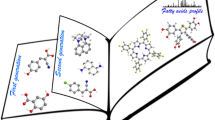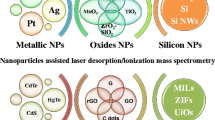Abstract
The chemical complexity of the metabolome requires the development of new detection methods to enlarge the range of compounds detectable in a biological sample. Recently, a novel matrix-free laser desorption/ionization method called nanostructure-initiator mass spectrometry (NIMS) [Northen et al., Nature 449(7165):1033–1036, 2007] was reported. Here we investigate NIMS in negative ion mode for the detection of endogenous metabolites, namely small phosphorylated molecules. 3-Aminopropyldimethylethoxysilane was found to be suitable as initiator for the analytes studied and a limit of detection in the tens of femtomoles was reached. The detection of different endogenous cell metabolites in a yeast cell extract is demonstrated.





Similar content being viewed by others
References
Amantonico, A., Oh, J. Y., Sobek, J., Heinemann, M., & Zenobi, R. (2008). Mass spectrometric method for analyzing metabolites in yeast with single cell sensitivity. Angewandte Chemie International Edition, 47, 5382–5385. doi:10.1002/anie.200705923.
Cohen, L. H., & Gusev, A. I. (2002). Small molecule analysis by MALDI mass spectrometry. Analytical and Bioanalytical Chemistry, 373, 571–586. doi:10.1007/s00216-002-1321-z.
Dettmer, K., Aronov, P. A., & Hammock, B. D. (2007). Mass spectrometry-based metabolomics. Mass Spectrometry Reviews, 26, 51–78. doi:10.1002/mas.20108.
Dunn, W. B., Bailey, N. J., & Johnson, H. E. (2005). Measuring the metabolome: Current analytical technologies. Analyst (London), 130, 606–625. doi:10.1039/b418288j.
Edwards, J. L., Chisolm, C. N., Shackman, J. G., & Kennedy, R. T. (2006). Negative mode sheathless capillary electrophoresis electrospray ionization-mass spectrometry for metabolite analysis of prokaryotes. Journal of Chromatography A, 1106, 80–88. doi:10.1016/j.chroma.2005.08.082.
Edwards, J. L., & Kennedy, R. T. (2005). Metabolomic analysis of eukaryotic tissue and prokaryotes using negative mode MALDI time-of-flight mass spectrometry. Analytical Chemistry, 77, 2201–2209. doi:10.1021/ac048323r.
Fiehn, O. (2002). Metabolomics—the link between genotypes and phenotypes. Plant Molecular Biology, 48, 155–171. doi:10.1023/A:1013713905833.
Fiehn, O., & Kind, T. (2007). Metabolite profiling in blood plasma. In W. Weckwerth (Ed.), Metabolomics, methods and protocols (pp. 3–18). Totowa, NJ: Humana Press, Inc.
Halimaoui, A. (1997). Porous silicon formation by anodisation. In L. Canham (Ed.), Properties of porous silicon (pp. 11–27). London: INSPEC.
Hillenkamp, F., & Karas, M. (2007). The MALDI process and method. In F. Hillenkamp & J. Peter-Katalinić (Eds.), MALDI MS: A practical guide to instrumentation, methods and applications (p. 3). Weinheim: WILEY-VCH.
Hollywood, K., Brison, D. R., & Goodacre, R. (2006). Metabolomics: Current technologies and future trends. Proteomics, 6, 4716–4723. doi:10.1002/pmic.200600106.
Nordstrom, A., Want, E., Northen, T., Lehtio, J., & Siuzdak, G. (2008). Multiple ionization mass spectrometry strategy used to reveal the complexity of metabolomics. Analytical Chemistry, 80, 421–429. doi:10.1021/ac701982e.
Northen, T. R., Yanes, O., Northen, M. T., Marrinucci, D., Uritboonthai, W., Apon, J., et al. (2007). Clathrate nanostructures for mass spectrometry. Nature, 449, 1033–1036. doi:10.1038/nature06195.
Peterson, D. S. (2007). Matrix-free methods for laser desorption/ionization mass spectrometry. Mass Spectrometry Reviews, 26, 19–34. doi:10.1002/mas.20104.
Shrestha, B., Li, Y., & Vertes, A. (2008). Rapid analysis of pharmaceuticals and excreted xenobiotic and endogenous metabolites with atmospheric pressure infrared MALDI mass spectrometry. Metabolomics, 4, 297–311. doi:10.1007/s11306-008-0120-8.
Soga, T., Ueno, Y., Naraoka, H., Ohashi, Y., Tomita, M., & Nishioka, T. (2002). Simultaneous determination of anionic intermediates for Bacillus subtilis metabolic pathways by capillary electrophoresis electrospray ionization mass spectrometry. Analytical Chemistry, 74, 2233–2239. doi:10.1021/ac020064n.
Sun, G., Yang, K., Zhao, Z. D., Guan, S. P., Han, X. L., & Gross, R. W. (2007). Shotgun metabolomics approach for the analysis of negatively charged water-soluble cellular metabolites from mouse heart tissue. Analytical Chemistry, 79, 6629–6640. doi:10.1021/ac070843+.
Tomita, M., & Nishioka, T. (2005). Metabolomics: The frontier of systems biology. Tokyo: Springer-Verlag.
Trauger, S. A., Go, E. P., Shen, Z. X., Apon, J. V., Compton, B. J., Bouvier, E. S. P., et al. (2004). High sensitivity and analyte capture with desorption/ionization mass spectrometry on silylated porous silicon. Analytical Chemistry, 76, 4484–4489. doi:10.1021/ac049657j.
Vaidyanathan, S., Jones, D., Ellis, J., Jenkins, T., Chong, C., Anderson, M., et al. (2007). Laser desorption/ionization mass spectrometry on porous silicon for metabolome analyses: Influence of surface oxidation. Rapid Communications in Mass Spectrometry, 21, 2157–2166. doi:10.1002/rcm.3078.
Villas-Boas, S. G., Mas, S., Akesson, M., Smedsgaard, J., & Nielsen, J. (2005). Mass spectrometry in metabolome analysis. Mass Spectrometry Reviews, 24, 613–646. doi:10.1002/mas.20032.
Weckwerth, W. (2003). Metabolomics in systems biology. Annual Review of Plant Biology, 54, 669–689. doi:10.1146/annurev.arplant.54.031902.135014.
Wei, J., Buriak, J. M., & Siuzdak, G. (1999). Desorption–ionization mass spectrometry on porous silicon. Nature, 399, 243–246. doi:10.1038/20400.
Woo, H. K., Northen, T. R., Yanes, O., & Siuzdak, G. (2008). Nanostructure-initiator mass spectrometry: A protocol for preparing and applying NIMS surfaces for high-sensitivity mass analysis. Nature Protocols, 3, 1341–1349. doi:10.1038/nprot.2008.110.
Acknowledgments
We thank Jennifer Ewald, Benjamin Volkmer and Dr. Matthias Heinemann from the Institute of Molecular System Biology for the yeast cultivation, metabolism quenching, and metabolites extraction. We also thank Dr. Frank Krumeich for the SEM measurements. This work was supported by the ETH-INIT “Single cell metabolomics” project.
Author information
Authors and Affiliations
Corresponding author
Rights and permissions
About this article
Cite this article
Amantonico, A., Flamigni, L., Glaus, R. et al. Negative mode nanostructure-initiator mass spectrometry for detection of phosphorylated metabolites. Metabolomics 5, 346–353 (2009). https://doi.org/10.1007/s11306-009-0163-5
Received:
Accepted:
Published:
Issue Date:
DOI: https://doi.org/10.1007/s11306-009-0163-5




